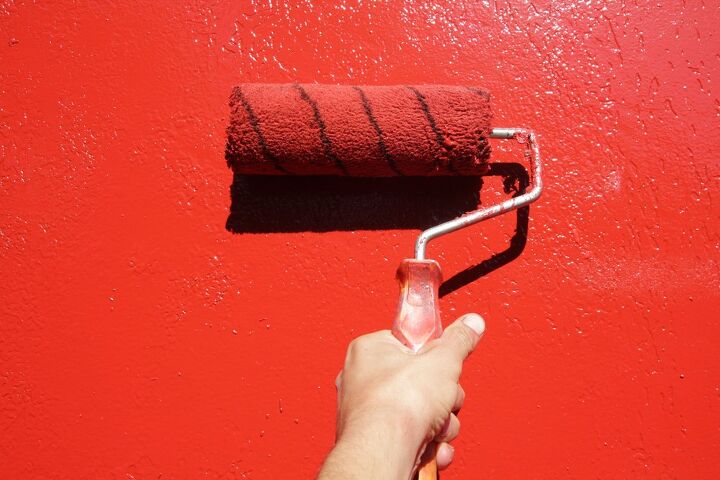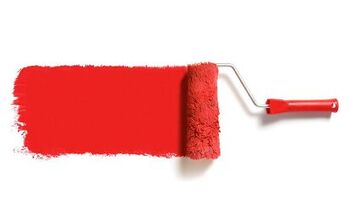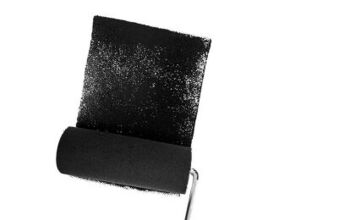What Is The Best Color Primer To Use For Red Paint? (Find Out Now!)

A fresh coat of paint instantly gives your home a refresh without taking a big bite out of the budget. But, typically, the prep is the most important part of the process with any paint job. When you’re painting with red paint, or painting over red, choosing the best primer is essential.
In most cases, the best primer to use when painting over red paint is a gray primer, like Rustoleum Zinsser 1-2-3 Primer. If you’re painting over a lighter color with red paint, a regular white primer like KILZ All-Purpose could work. However, using a gray or tinted primer can enhance the red color and keep it from going too pinkish.
Many people assume they don’t have many choices regarding primer, but several different types fill home improvement shelves. You can opt for tinted primers, white or gray primers, primers with stain blockers, oil-based primers, exterior applications, etc. Therefore, before starting any paint job, it’s worth digging in and finding the best primer for your specific needs.
Do You Need to Hire a Paint Contractor?
Get free, zero-commitment quotes from pro contractors near you.

Why Do I Need to Use Primer When Painting?
While you can paint your walls and trim without priming, it’s not likely to result in the best paint job. Priming helps create a smooth, clean surface for your new, fresh coat of paint. It also ensures a longer-lasting, more durable paint job that will look great and professional.
If that isn’t reason enough, priming before you paint is also a lot easier on your pocketbook. Due to the composition of primer, it doesn’t soak into surfaces as readily as paint. Therefore, you won’t need to use as many coats of paint to finish the job.
Considering primer usually is less costly than paint, this is a win-win. Besides saving you some money, this can also save you some time.
Certain surfaces can absorb paint like crazy, requiring 5 or 6 coats or more before you could get full coverage. But, if you apply one or two coats of primer first, you typically need two coats of paint max.
Additional Benefits of Priming Before Painting
Besides saving you money and effort, priming before painting has many other benefits:
- Many primers are fast-drying, meaning a speedier job for you since you don’t have to wait as long between coats.
- Using the right primer helps cancel out the existing paint color, allowing the new paint to show its true colors.
- Primer helps prevent peeling, fading, and other unsightly issues with your paint job.
- Using a primer helps block stains and seal the surface, so those stains don’t bleed through your new paint job.
- Priming helps provide an even surface for your paint and increases the adhesion of the paint. This is because primer typically consists of more resins than paint.
Typically, when painting most interior walls, you’ll only need one or two coats of primer. Exterior applications or certain other materials may require two coats of primer.
What Primer Is Best for Painting Over Red Paint?
Choosing the right primer is critical if you have a red wall that you’re ready to paint over. Otherwise, you can end up with a new color that doesn’t come across the way you hoped. Or, you end up having the red paint bleed through the new coat of paint.
At the very least, you may end up having to use too many coats of primer or paint. Either way, the result is wasting time and money, all for an ending color result that you don’t really want.
Therefore, if painting over a red wall, one of the best options is using a water-based, sealing gray primer. It’s also vital to choose a primer with stain-blocking qualities.
A great example is Rustoleum Zinsser 1-2-3 Primer. It’s specially formulated to cover deep, dark colors, plus has excellent stain-blocking capabilities and works on multiple surfaces.
Another good option is to get a tintable primer. Tint it in a color as close a possible to the new color you are painting.
Can Paint/Primer Combos Work Over Red Paint?
Although paint-and-primers in one offer excellent coverage and can save time, they might not be the best for covering red. It can be done, but you’d likely need too many coats to make it worth the hit to your wallet.
What Primer Is Best If Using Red Paint?
On the flip side of the coin, what if you’re painting with red paint? What’s the best primer to use underneath red paint, so you get the right shade of red?
Often using a typical white primer can end up giving you a pinkish look. This pink undertone is anything from the rich, bright, or deep red shade you were hoping for on your walls.
Luckily, ensuring you use the appropriate primer will give you the color that you see on the swatch. If you’re painting red over a light color, using a gray primer will work, helping bring out the true red hue. Tinted primer, using the color you plan to paint, will also work like a charm.
For painting over a light color with red paint, a paint-and-primer-in-one is also a great option. However, stick with the gray or tinted primer alternatives if you’re painting over a darker color.
Tips for Choosing the Right Primer for Your Paint Job
With so many options out there, how do you pick the best primer for your paint job? Here are a few tips to help steer you in the right direction.
- Before buying primer, you need to know the details of your painting job. Most importantly, what type of surface and where is it.
- For painting over unfinished wood, use a latex or oil-based primer. If the wood has a stain, make sure to use a primer with a stainblocker.
- If painting exterior surfaces, choose an exterior primer that protects against mildew and mold.
- If you’re painting both indoor and outdoor areas, ensure you get an all-purpose primer designed for indoor and outdoor use. If only painting inside, opt for a high-quality indoor primer.
- For painting drywall, a latex primer is best.
- When painting over a previously painted surface, in most cases, paint-and-primer combos can save you a lot of time.
- If painting metal, find a primer with corrosion resistance.
- Shellac primers work well on surfaces with smoke damage and for blocking strong odors, such as animal smells.
- If you’re painting over glass or other shiny, smooth surfaces, make sure you get a bonding primer.
Always Prep Before You Prime
No matter what primer you choose, always properly prepare your surface as needed. This could mean sanding off chipped paint, cleaning the area thoroughly, and spot-priming over major stains.
Do You Need to Hire a Paint Contractor?
Get free, zero-commitment quotes from pro contractors near you.

Related Questions
Will a paint-and-primer-in-one cover well with just two coats?
In most interior home applications, using paint-and-primer-in-one can save you a lot of time. You typically can get the job done well with just two coats. However, there are a few cases where you might still want to opt for regular primer first. Paint-and-primer costs more than a traditional primer, understandably so. In some situations, you’ll be using up more of the costlier paint on an extra coat or need to purchase more. For example, if you’re painting over an unfinished surface, you might want to do one coat of regular primer first. Things like unfinished wood, plaster, and drywall tend to soak up paint, so you’ll likely need two coats of primer. Paint-and-primer-in-one is more expensive than a regular primer. Therefore, for example, if you’re painting plywood, apply a coat of regular primer first. Then finish with two coats of the paint-and-primer-in-one.
How much does primer cost?
Depending on what size paint can you get and the type of primer, your cost for primer will vary. A decent-quality, white primer will cost about $15 for a gallon. Primers with more features, like mold resistance and higher quality, can cost closer to $25 to $40 per gallon.On average, it’s more cost-effective to get primer (and paint) in larger sizes if you know you’ll need it. For example, a quart of KILZ-2 All-Purpose, Interior/Exterior Primer with sealing and stain-blocking costs about $10 for a quart. However, a gallon (or 4 quarts) of the same paint costs about $19. If you have a big painting project ahead of you, for example, painting your whole house, consider larger buckets. For example, the KILZ-2 mentioned above costs about $86 for a 5-gallon bucket or roughly $46 for 3.5 gallons.

Stacy Randall is a wife, mother, and freelance writer from NOLA that has always had a love for DIY projects, home organization, and making spaces beautiful. Together with her husband, she has been spending the last several years lovingly renovating her grandparent's former home, making it their own and learning a lot about life along the way.
More by Stacy Randall



























